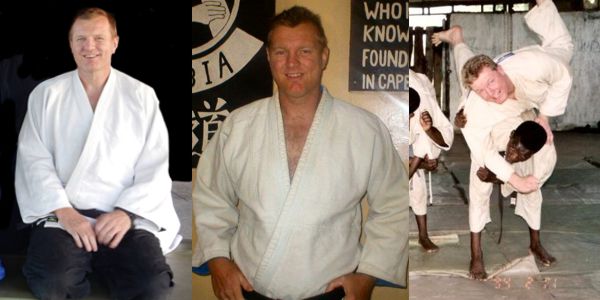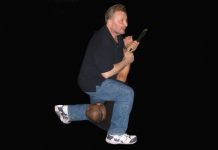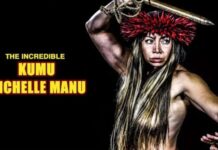I would like to share some of my early experiences of training judo and jujitsu in Osaka Japan. When I left for Japan in 1991 at the age of 19, I had been doing judo for 4 years, first under my father, Sensei John Kruger and then under Father Jude McKenna in Lusaka, as well as Sensei Hiromitsu Umino who worked for the JOCV organization, (Japan Overseas Cooperation Volunteers).
At the time I was to go to Japan I had just received my brown belt – Ikkyu, at the kodokwan judo club in Kitwe, Zambia from my father. I won my first big judo tournament on my 18th birthday, the YMCA Open Judo Championship. I had also taken a judo course with Sensei Keith Tiger Brown ‘s Dojo in Sheffield England. Sensei Brown at the time was a 6th dan and had won the masters judo tournament 7 times in the UK. Having won quite a few local and national tournaments in Zambia, I felt I was ready to take on the Japanese judo clubs and I was feeling pretty good about myself and on top of the world. This was all about to change when I arrived in Japan. I went to work in Osaka, Takatsuki-City for a Christian organization called Youth With A Mission or YWAM, working with the organization as well as teaching English to support myself.
Many people involved in the traditional Japanese martial arts like me, sooner or later get the urge to train in Japan. I think this is a good idea for those who take their training seriously. As for the Japanese themselves, there is a saying, “to understand the Japanese you have to be Japanese”. I have been interacting with the Japanese for over 22 years now and I find this statement to be generally true. I have come to understand that as long as you do not try to understand them, you will get along very well. They understand that you are a foreigner, Gaikokugin, or just Gaijin to many of the locals in their country and they do try hard to introduce you to their culture. It gived them great pride to try and explain the way they look at things. If you go to Japan to train in Budo, you are expected to know how to behave in a dojo. When you speak a “little Nihongo” Japanese and if you have previously trained under a Japanese sensei, a lot more is expected of you. If you make too many mistakes, they will not say much, but do not be surprised if you are not invited back to their dojo. One more important point to understand about a Japanese sensei is he expects you to watch and listen, and not to ever try to explain that what he is teaching you isn’t the way you were taught.
Each dojo in Japan has its own particular sound of that emenates from the dojo. For example, in a Kendo club you will hear screams called Kiai and the clacking sounds of the shinai hitting against one another. At a karate dojo you will hear the sharp Kiai as well as the strong stamping sounds on the wood floor. Now at any judo, aikido, and jujitsu club you will hear the strong Kiai, but you will also hear an unusual booming sound. This sound comes from the budoka slapping the tatami mats with their hands when they get thrown. In a judo dojo you will hear the head senpai shout Fuaitou! – Fight on! And Yoshi-koi! – Come on! So on the first day I arrived in Osaka I and a friend took the afternoon to walk though the small narrow streets listening for the familiar booming sounds of a judo dojo. Finding a judo or karate club you wish to visit is quite a problem, particularly in the larger cities. At times the Japanese street numbering can be very poor. I came across two very strong judo clubs in Takatsuki City .The Takatsuki Shimin taikukan and the Kongo kyo koko gukuin. This is where my taste for true budo begain.
When I walked into the dojo and introduced myself as the Zambian Gaijin who wanted to practice at their dojo, I was welcomed by the head instructor. They even gave me two nice Judogi. I had come from Zambia with only one judo gi. I told them about judo in my country and told them that I was a 1st kyu Brown belt. The head instructor Mr Takeda said I could start the following afternoon. When I arrived the next day I was introduced to all the students in this beautiful judo dojo. When the practice began I was astonished to find myself in the beginners class practicing my break falls (ukemi-waza) and other basics and foundations of judo with 5 other Japanese White belts. I did this for the first day. I was allowed to perform a few break falls from my club in Zambia that they had never seen, such as the jujitsu ukemi – waza. When Mr Takeda saw that I was able to do all the break falls to his satisfaction and that I understood all the basics, I was told that I could practice with all the seniors the next day .The following day I was told by Mr Takeda that if I wanted to keep my brown belt in his club I would have to prove myself worthy to wear it in Japan. I was told that if I could withstand one week of training with them, only then, would I be allowed to keep it. I did not know it at the time, but had been thrown into the lion’s den.
All the yudansha black belts were told to make or break this Zambian gaijin with some of the harshest training I had ever experienced. I was thrown, arm-locked and then strangled into submission! At this point, let me share a little about what the Japanese call Shime- waza (strangling techniques). To some, the idea of being strangled out is will make them tap in submission, others talk in a blasé manner about their pleasant dreams after they have been rendered unconscious. None can deny that a properly executed strangle is a quick way of gaining an ippon. During that week I was on the wrong end of those strangles. At this club the students knew the foreigners generally loathed strangles. They each took turns, especially the sempai, working for a strangle. The worst strangle technique against me was called a Jigoku jime, (hell’s strangle). After going out for the third time I realized I was being played with. I had two choices. I could get upset and leave the dojo, never to return to train, or I could accept the fact that I was being put through some kind of test and learn to take the strangles. I was strangled out so many times that I could not think properly anymore. It was not a pleasant experience and I could not speak properly especially responding in Japanese. I also had a thumping headache for a day. My dojo mates loved watching me go blue in the face and the head sempai would walk around with a bamboo shinai striking us on the back if we did not fight hard enough. (When I left Japan in 1998 one of the head sensei gave me his Shinai to help me remember all the training lessons I had experienced. I did get through that terrible week, and before walking into the dojo, I would humbly don my brown belt.
During one summer judo course Sensei Takeda asked me if I was interested in taking part in a special kind of training where we would be lined up against another judo club and we would fight randori for one hour without resting. It was during this course that I met the greatest judo master ever! Our club had a visiting club from down town in Ibaraki city near Osaka and in the morning we had a tournament between the two clubs. I was put up against two sho dans from the other club. I managed to throw both of them with Osoto-gari, (Major outer reaping throw for ippon). In the afternoon our two clubs would get the chance to practice together. It was during this time an old sensei walked into the dojo, he looked to be around 70 years old. All at once everyone in the club bowed to him. He wore a red and white striped belt. The head instructors gave him a chair and he sat to watch us practice. He at once noticed me, the only foreigner fighting on the mat. I noticed he kept looking my way. I was on a roll that day having thrown 2 black belts in the morning and another 5 black belts from the visiting club in practice in the afternoon. He stood up and called to me in Japanese, Oi boya oide! Hey boy, come here. Shobu sho, lets practice together. I thought to myself, what an honor to practice with such a great master of judo. I told myself I will go easy on him out of respect. I could see all students smiling at me thinking Sayonara Jonasan. He got up from the chair and then staggered on to the tatami, but once on the mat he perk up like a lamb in spring. Remarkable! After we bowed to each, he shouted Yoshi koi, come on! When I took hold of his jacket I felt something very strange, I could not feel his body inside his jacket. It was almost as if he had become water. That’s when I realize I was on the mat with the wrong guy.
He was a very skillful man and I never felt him throw me with Morote seoinage, I was simply staring up at the ceiling. You felt nothing before he threw you. No warning. He had superb balance. In the five minutes I fought him I never threw him once, but he threw me more than 10 times with the same technique Morote seoinage. After our practice we bowed and he staggered off the mat and sat down. I came to his side and knelt down and asked him how he could throw me so easily. His answer to this was, everybody has some kind of fault or weakness in their movements. I asked him what was I doing wrong in my movement to be thrown so easily, but he would not tell me. He just told me to carry on practicing and perhaps in 30 years I too could do the same as he did to me. After this I was able to train with Mr Arao Sensei from the Tennoji Aikikan. Sensei Arao was a 5th Dan in Tomiki-Aikido and Aiki jujitsu and this man was incredible. He could throw you without holding your jacket and I have never felt so much pain as when he applied a technique.
During one of our training session with Sensei Arao a high ranking shotokan karate instructor came to visit he had just won a major shotokan tournament and was kind of bragging about his victory. Anyway, he got in to a long conversation with Sensei Arao about which martial arts was better. After this conversation they both step on to the mat and faced each other, Sensei Arao was going to use jujitsu and the other shotokan sensei was going to use karate. All the students sat down to watch the results of the match I was really excited and eager to see which sensei would gain the upper hand. I was expecting something from a Bruce Lee movie. After 5 minutes we saw very little action as neither would attack, eventually they bowed to each other and agreed that it was difficult to fight someone from another martial art. Sensie Arao said to me later and I quote “remember also that all martial arts are defensive”.
Karate kata start with a block. In Aikido someone must attack you for the technique to work. In judo someone has to take hold of you or attack you.” If a 10th degree Black Belt in Judo and a 10th Degree Black Belt in Karate squared off and all variables were equal, age and weight, who would win? Some would say Karate others would say Judo but they would be wrong. Sensei Arao said the correct answer is simple, no one would win. There would not be a fight if all things are equal, neither man would attack. If one attacks in such circumstances, he would lose everything for the attack would create a weakness in the art.
“Although I have been through all that I have. I do not regret the many hardships I met, because it was they who brought me to the place I wished to reach.” Quoted by Paul Coelho in the book ‘Manual of the Warrior of Light’.






